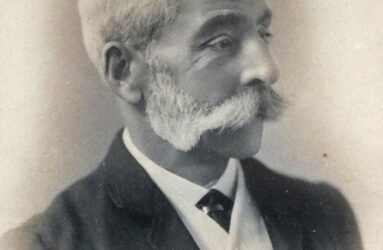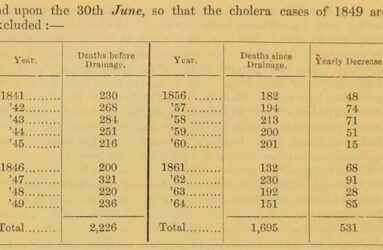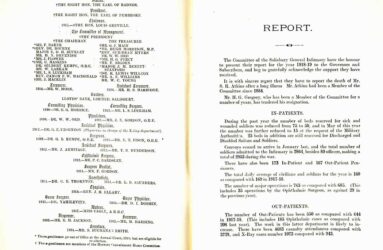
Public Health & Epidemics
Plague
In the 1600s when the plague was sweeping across the country the local council ordered many measures to combat infection. These included no carriages or goods to be received into Salisbury from outside the area. Laws were passed to stop vagabonds wandering the country and spreading the disease. Strangers too were banned and a watch was put on the streets to prevent their access.
Special arrangements were made too for supplies of corn to be delivered to local weavers of Salisbury, Devizes, Marlborough and Fisherton Anger who were losing work and becoming destitute because of their isolation and unable to conduct their usual business. 369 people died and Mayor, John Ivie, remained to coordinate care for those unwell and uphold the law during this time.
Smallpox
It is recorded that in 1803 the House Apothecary of Salisbury Infirmary was requested to perform inoculation of patients for free with the new vaccine, developed by Edward Jenner, against smallpox. Inoculation had previously been risky and public had concerns about people who had been vaccinated infecting others. His research began when he noticed milkmaids, who had been infected with cowpox (similar disease but much less harmful) protected them against the more dangerous smallpox. Jenner’s discovery changed the way diseases were understood and treated.
Later in 1849 a very serious outbreak of cholera hit the city. Mr W D Wilkes (pictured), House Surgeon of the Infirmary, treated 5 cases at the hospital.
The annual report of that year states:
“The Auditors are unwilling that the services of the House Surgeon at that trying period should be unnoticed, and, therefore, cheerfully bear testimony to his unwearied attention to those patients, who, in the hour of danger and alarm, sought his aid”
Cholera
In 1849 there were 165 deaths in the city from cholera.
At the time Salisbury was a busy densely populated city more so than industrial areas in the north. It had one of the highest death rates in the country at that time and led to a major project to drain, construct, improve waterways and rebuilt the city. Before the drainage project death rates were around 27 in 1000 per year as compared to afterwards around 20 in 1000. With outbreaks of diseases such as typhoid and diarrhoea studied during the research.
The city was now described:
‘First, as to changes evident to the senses. Instead of dirty canals with dirty streets sloping towards them, the streets are now rounded in the centres and clean’ ‘dry instead of moist; sweet, instead of stinking’. The records show that in the nine years since the Salisbury drainage project 531 fewer deaths occurred than in the previous 9 years.
Spanish Flu
Salisbury General Infirmary seemed to be so overwhelmed with WW1 casualties, lack of staff and food, coupled with financial burden of 4 years of war that not much is written about the epidemic. These social factors may also have contributed to making the epidemic worse ie. malnourishment and poor living conditions and smoking.
We have some material from the period that provide facts and figures regarding influenza in 1918/1919. Salisbury General Infirmary (SGI) annual reports, records show 62% increase in deaths to the previous year, these happened predominately Autumn 1918 and again early Spring 1919 which are when the infection peaked. Larger percentage of males to females and more than half were between 20-40 age range.
Potential topic to research could look at why so many younger people died ? 80% deaths were those under 40. Was this due to an earlier milder outbreak that meant older people had some immunity or another reason?









